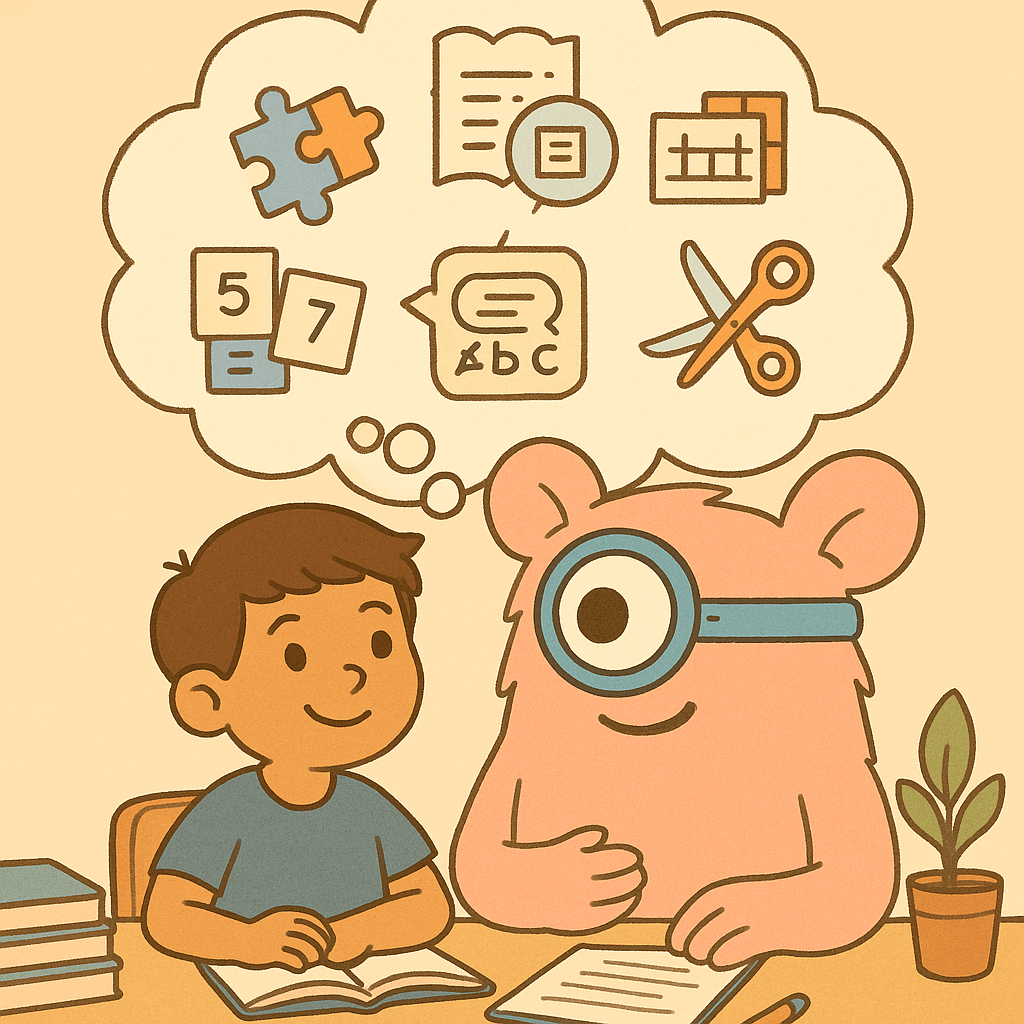6 Reading Friendly Hacks for Kids Who Hate Word Problems.
TL;DR: Word problems are a persistent hurdle with many students, and the challenge is even bigger for neurodivergent learners who may struggle with language load, working memory, and abstract reasoning. Research shows that with the right support these tasks become far more accessible. When instruction reduces unnecessary barriers and builds on core math understanding in supportive low stress ways, word problems feel clearer, less overwhelming and more achievable, shifting them from dreaded puzzles into challenges that students handle with confidence.
What Makes Word Problems So Tricky
Word problems sit at the cross roads of math and language and that's exactly what makes them tricky and difficult. Students who can calculate easily may often freeze when problems come wrapped in sentences, storylines and extra details, faced with text, numbers, and context all at once. Unlike straight forward equations word problems require kids to read carefully hold information in the mind pick out what's relevant and then decide how to translate words into numbers. That's a lot of cognitive juggling.
For neurodivergent learners those with ADHD, dyslexia, autism, dyscalculia, or language-based learning difficulties the challenge is even bigger. The issue isn’t ability; because these students can understand the math concepts well, but word problems demand advanced skills in reading comprehension, working memory and executive function which can easily become bottle necks. The result frustration shut down or the thought that they "just aren't good at math".
The encouraging news is that research consistently shows students thrive when these barriers are addressed directly. With supports that reduces language load, scaffold executive function, and make abstract ideas concrete work problems shift from overwhelming to manageable.
Let's dive into six research backed reading-friendly hacks that can help neurodivergent learners build confidence with word problems. Each of these is supported by peer reviewed studies and focuses on helping neurodivergent learners reduce cognitive load, build confidence and strengthen math facts and pre-algebra skills.

Hack 1: Use Schema-Based Instruction & Problem Type Recognition
Teaching students to recognize the structure of problems like combine (putting things together), compare (looking at differences), or change situations (increasing or decreasing pattern) helps them map new problems to familiar types. Studies on schema-based instruction for students with autism show it improves problem solving and flexibility.
Practical ways to build this foundation includes:
- Showing labeled examples of each type.
- Using the concrete → representational → abstract sequence. Starting with hands on manipulatives, moving to drawings, and then to equations, a progression that's proven effective in special education math interventions.
This approach reduces novelty, provides patterns, and lowers memory load, by giving students a reliable anchor.
More strategies appear in why autistic kids may struggle with word problems (and how to help).
Hack 2: Explicit Vocabulary Instruction
A common barrier in word problems is not the math itself but the language. Words like difference, less than, altogether etc. carry specific mathematical meanings that don't always match how students use them in everyday conversation. Adding explicit vocabulary instruction to schema teaching significantly boosts performance for students with math difficulties.
Practical ways to build this foundation include:
- Pre-teaching math words before problems, so that students don't have to puzzle out meaning and math at the same time.
- Using visuals like word maps with definitions and examples giving students multiple ways to "see" what the word means.
- Reinforcing with short activities like matching or fill-in-the-blank prompts, helping students practice words in context.
This anchors language so students can focus on understanding the structure of the problem and using the right reasoning to solve it.
Hack 3: Visual Supports & Multiple Representations
One of the most effective ways to support students with math problems is to make the math visible. Instead of holding information in their head students can "see" the relationship right in front of them reducing the strain on working memory. Research shows that visual models and multiple representations improve comprehension and flexibility for students facing math difficulty.
Practical ways to build this foundation include:
- Starting with concrete manipulatives like blocks, counters or small objects helps students act out the story problem.
- Moving to pictorials like bar models, ratio tables, or number lines helps structure information reducing the load on working memory.
- Encouraging students to sketch what’s happening in the problem using stick figure drawings or simple diagrams can anchor thinking and make abstract problems feel more approachable.
Each of these lighten the cognitive load and offer a stable reference point. Students can reflect back on the drawings, trace relations and reason with clarity.
Practical classroom ready examples are described in visual math strategies that actually work for neurodivergent kids .

Hack 4: Break Into Chunks & Try Numberless Word Problems
Instead of overwhelming students with long text and numbers, chunk the problem into parts or first present it without numbers. Teachers using numberless word problems report that students focus more on meaning before computation. Research also shows that when arithmetic word problems include complex features such as multiple steps or irrelevant numbers, reading comprehension and working memory become much stronger predictors of success.
Practical ways to build this foundation include:
- Reading once without numbers and discussing the story, listing down knowns/ unknowns and crossing out irrelevant details before solving.
- Revealing numbers gradually so that students connect each number to its meaning.
- Solving step by step by creating a short plan ("Find the total walnuts and then the difference") solve and check if the answer against the story. ("Does it make sense?")
These steps lower the cognitive load by offering explicit support with language and working memory
Hack 5: Teach Metacognitive Routines
When students face a dense problem it can feel like a tangle of words and numbers with no clear entry point. Structured strategies like “Read → Underline → Decide what’s being asked.” helps bring structure to what feels complex. Research on metacognitive routines in math highlights how giving students explicit problem-solving steps supports planning and comprehension. At the same time, peer-reviewed research shows that students with stronger metacognitive skills perform significantly better on non-routine math problems.
Practical ways to build this foundation include:
- Modeling think-alouds while solving, makesinvisible thinking visible. (First I will re- read the question, then I will underline the keywords)
- Providing posters or checklists as guides reminds students of the steps until they become second nature. .
- Fading support gradually as students internalize routines instead of relying on external guidelines.
This gives students a roadmap when problems feel chaotic and helps them monitor their own thinking.
Hack 6: Build Fluency with Math Facts & Pre-Algebra Foundations
Word problems are easier when computation feels automatic. If a student has to labour over each addition, subtraction or multiplication fact, working memory gets clogged with computation leaving little space to comprehend the problems story. Studies confirm that math fact fluency frees up working memory so students can focus on comprehension.
Practical ways to build this foundation include:
- Using short bursts of retrieval practice like quick sprints of flash cards, quizzes or digital games reinforces math facts without overwhelming students.
- Connecting fact practice directly to problem schemas by highlighting how knowing facts of 10 or doubles makes working with "compare" problems easier.
- Introducing visuals like algebra tiles or number lines show how facts connect to larger structures easing the transition to abstract problem solving.
Monster Math does all this and more.
Fluency reduces stress and boosts confidence making problem solving smoother faster and motivating.
Turning Word Problems Into Wins
Neurodivergent learners thrive when word problems are broken down, visualized, and language made accessible. With schema teaching, vocabulary support, visuals, chunking, strategy routines, and fluency building, math shifts from overwhelming to approachable. Over time, students who once dreaded word problems gain confidence and problem-solving skills that carry into pre-algebra and beyond.
FAQs
Q: Should kids use keywords like “more than” or “left”?
A: Not as the only strategy. Research shows schema recognition works better than keyword spotting.
Q: When should we start using these supports?
A: Early schema and vocabulary instruction in elementary grades prevent gaps from widening.
Q: How can non-verbal or low readers engage?
A: Use pictures, manipulatives or drawings. Visual scaffolds work even without heavy text.
Q: How do we reduce frustration?
A: Make problems relatable, break them into steps, and celebrate small wins.
References
- Root, J. R., Ingelin, B., & Cox, S.K. (2021). Modified Schema-Based Instruction to Develop Flexible Mathematics Problem-Solving Strategies for Students With Autism Spectrum Disorder. Remedial and Special Education. ERIC PDF
- Stevens, E. A., Leroux, A. J., Mowbray, M. H., & Lee, G. S. (2023). Evaluating the Effects of Adding Explicit Vocabulary Instruction to a Word-Problem Schema Intervention. Exceptional Children. Journal Link
- Powell, S. R., & Fuchs, L. S. (2018). Using Schemas to Facilitate Mathematical Reasoning. Journal of Learning Disabilities. PMC
- Verschaffel, L., Van Dooren, W., Greer, B., & Mukhopadhyay, S. (2021). Complexities in Arithmetic Word Problems: Effects on Working Memory and Reading Comprehension. Cognitive Processing. PMC
- Iowa Reading Research Center (2025). Literacy in Every Subject: Math and Word Problems.IRRC Blog
- Güner, P., & Erbay, H. N. (2022). Metacognitive Skills and Problem-Solving Performance of Middle School Students. Journal of Pedagogical Research. ERIC PDF

